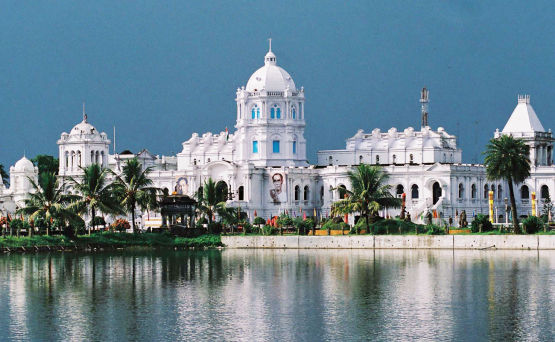In recent years, North East India has witnessed a substantial boost in infrastructure development across sectors such as transportation, energy, digital connectivity, and industrial growth. These developments are aimed at overcoming geographical isolation, improving regional integration, and enhancing economic growth. The region, known for its strategic location, rich natural resources, and cultural diversity, is now becoming a focal point for major industrial and infrastructure projects. Among the various sectors, notable advancements include the setting up of semiconductor industries, mega bridges to improve connectivity, and expansions in road, rail, and air networks. Recent infrastructure development in North East India has been transformative, positioning the region as a gateway to Southeast Asia and a hub for trade, tourism, and industry. The region’s improved connectivity, growing industrial base, and investment in high-tech sectors such as semiconductors are unlocking its economic potential, while strategic initiatives in transport, energy, and digital infrastructure are integrating the region more closely with the rest of India. These developments not only address the region’s historical challenges of isolation and underdevelopment but also set the stage for future growth and prosperity.

Mega Bridges: Enhancing Connectivity
• Dhola-Sadiya Bridge (Bhupen Hazarika Setu): Inaugurated in 2017, the Dhola-Sadiya Bridge is India’s longest road bridge, spanning 9.15 kilometers across the Brahmaputra River. This bridge connects Assam’s Tinsukia district with Sadiya in Arunachal Pradesh. The Dhola-Sadiya Bridge has reduced travel time between Assam and Arunachal Pradesh, enhancing both civilian and military movement in this strategic border region. It is also expected to boost economic activity by facilitating faster transportation of goods and fostering better trade links with Arunachal Pradesh.
• Bogibeel Bridge: Another significant infrastructure achievement, the Bogibeel Bridge, is a 4.94 km-long road-rail bridge across the Brahmaputra River connecting Dibrugarh in Assam to Dhemaji. This bridge has improved connectivity to the eastern parts of Arunachal Pradesh and Assam, playing a critical role in improving military logistics and reducing travel time for civilians.
• Saraighat Bridge Expansion: The Saraighat Bridge in Guwahati, Assam, has long been a vital link connecting the northeastern region with mainland India. In recent years, the expansion of this iconic bridge has improved traffic flow, facilitating faster and more efficient transport between Assam and the rest of India.
Rail Connectivity Expansion
• The conversion of meter-gauge to broad-gauge has been completed on several key routes, including the Lumding-Silchar line, which is essential for connecting Assam with the southern districts of the state and Tripura.
• Projects like the Jiribam-Imphal railway line aim to link Manipur’s capital Imphal with the rest of India for the first time, a crucial development expected to transform the economic landscape of Manipur.
• The construction of the Agartala-Akhaura rail link, connecting Agartala, Tripura with Akhaura in Bangladesh, is a critical step toward strengthening international trade and reducing the travel distance between the North East and Kolkata via Bangladesh.
.jpg)

Semiconductor Industry with Tata Group and Government of Assam
• Semiconductor Manufacturing Plant: A semiconductor manufacturing plant is being established in Jagiroad, located near Guwahati, with the involvement of the Tata Group. This is part of India's broader efforts to become self-reliant in semiconductor production, a critical industry for electronics, automotive, and IT sectors.
• Industrial Boost for Assam: This project is expected to bring high-tech industrial growth to the region, offering employment opportunities and positioning Assam as a hub for electronics manufacturing in India. The establishment of such an industry in Assam underscores the region’s potential in contributing to India's "Make in India" initiative.
Air Connectivity
Air travel in North East India has expanded rapidly in recent years, driven by new airports, enhanced connectivity, and the subsidized air travel scheme UDAN (Ude Desh Ka Aam Nagrik).
• Pakyong Airport (Sikkim) and Hollongi Airport (Arunachal Pradesh) are two notable new airports, improving access to the remote Himalayan regions.
• Existing airports, such as Lokpriya Gopinath Bordoloi International Airport (Guwahati), Agartala, and Imphal, have been modernized, with more passenger amenities and better cargo handling facilities.


Energy Infrastructure and Power Projects
North East India has immense potential for hydroelectric power generation, thanks to its abundant river systems. In recent years, significant progress has been made to harness this potential.
• Subansiri Lower Hydroelectric Project: One of the largest hydroelectric projects under construction in Arunachal Pradesh, this project is expected to generate thousands of megawatts of power, contributing to the energy security of the region and the nation.
• North East Gas Grid: The construction of the North East Natural Gas Pipeline Grid aims to connect all the North Eastern states with a network of natural gas pipelines, providing industries and households with cleaner and more efficient energy.
Digital and Telecommunication Infrastructure
The Digital North East Vision 2022 has played a crucial role in expanding digital connectivity across the region. Key developments include:
• BharatNet Project: Under the BharatNet project, fiber-optic cables have been laid across the North East, bringing high-speed internet to remote and rural areas. This has opened up opportunities for e-governance, online education, and e-commerce, helping to integrate the region with India’s digital economy.
• Telecom Connectivity: Telecom infrastructure has expanded, with new 4G towers being installed in remote areas of Arunachal Pradesh, Nagaland, and Manipur. This is crucial for promoting tourism, education, and businesses in the region.

Urban and Industrial Growth
Recent infrastructure projects have also focused on urban development and industrial growth, particularly in the capitals and key cities of North East India.
• Smart Cities Mission: Cities like Guwahati, Agartala, and Shillong are part of India’s Smart Cities Mission, aimed at upgrading urban infrastructure with better public transportation, waste management, and digital amenities.
• Industrial Hubs and SEZs: The establishment of special economic zones (SEZs) and industrial hubs, such as the Food Processing SEZ in Assam, is encouraging investment in sectors like IT, agro-processing, and textiles.












